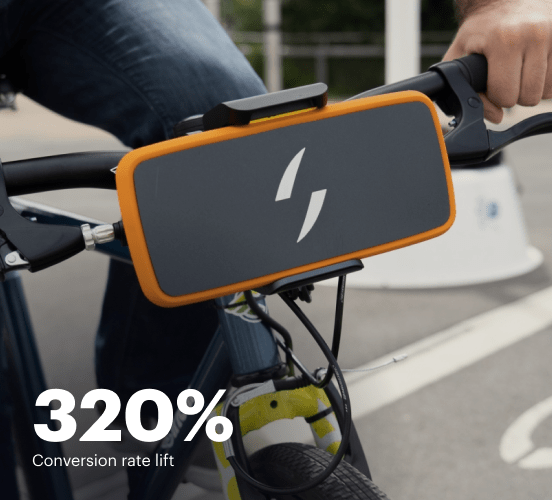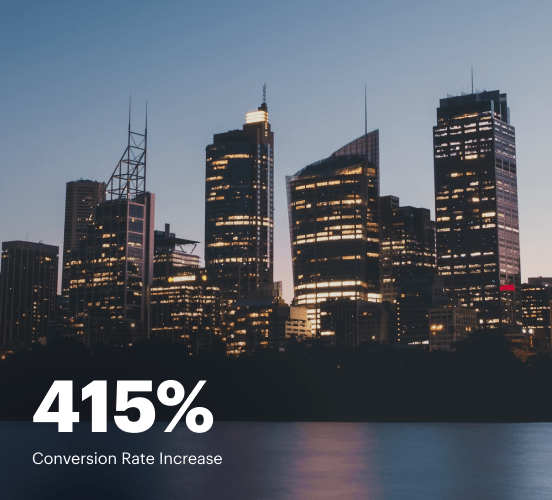Shopify vs. WordPress: the best platform for a seamless web experience
Discover how Shopify compares to WordPress regarding features and usability. Find out which platform provides the competitive advantage your business deserves.
Get startedSee how Instapage stacks up against the competition
| Feature | Instapage | Other builders |
| Drag-and-Drop Tools | ||
| Conversion-optimized templates | ||
| Manual and AI-powered A/B Tests | ||
| AI content suggestions | ||
| Popups and sticky bars | ||
| Canvas and grid blocks | ||
| Reusable and global elements | ||
| Form and popup builders | ||
| Built-in Heatmaps | ||
| Central analytics dashboard | ||
| Ad-to-page personalization and collections | ||
| Contacts, lists, and email | ||
| Dedicated, full-service CRO experts | ||
| Enterprise-ready platform |
Leading the way in building high-performing landing pages





Why Instapage is the smarter choice for your campaigns
Get everything you need to build, scale, and optimize high-converting landing pages—without coding.

Easier page building without coding
Instapage offers a flexible and seamless page creation experience with a library of 500+ conversion-focused layouts, Instablocks®, a drag-and-drop builder, and AI content generation. With technologies like Thor Render Engine®, you can create on-brand, mobile-responsive landing pages that load quickly and start converting during initial visitor clicks.

More insights — better results
Instapage lets you see in detail how each landing page experience and variation is performing so you can make targeted changes that boost page conversions. Use heatmaps for a better understanding of on-page activities, run A/B tests and AI-assisted experiments, and then track and evaluate results within robust analytics dashboards.

More personalized experiences
Instapage lets you quickly create high-performing landing pages tailored to each of your ad campaigns. Deliver personalized experiences for distinct audiences using dynamic text replacement. Effortlessly align specific advertisements to unique pages with AdMaps. Monitor audience-level metrics using our advanced data tools.

Built-in collaboration
Instapage collaboration capabilities bring your entire team together to speed up the process of landing page review, approval, and launch. No more frustrating and unnecessary revisions or edits scattered across emails. Provide instant feedback, conduct real-time page edits, and securely share your pages with outside stakeholders.

Free up time for your business
Invest time into business growth, not busy work. Launch landing pages faster with reusable forms and templates. Build once, reuse forever.
Explore all integrations






Easier page building without coding
Instapage offers a flexible and seamless page creation experience with a library of 500+ conversion-focused layouts, Instablocks®, a drag-and-drop builder, and AI content generation. With technologies like Thor Render Engine®, you can create on-brand, mobile-responsive landing pages that load quickly and start converting during initial visitor clicks.
More insights — better results
Instapage lets you see in detail how each landing page experience and variation is performing so you can make targeted changes that boost page conversions. Use heatmaps for a better understanding of on-page activities, run A/B tests and AI-assisted experiments, and then track and evaluate results within robust analytics dashboards.
More personalized experiences
Instapage lets you quickly create high-performing landing pages tailored to each of your ad campaigns. Deliver personalized experiences for distinct audiences using dynamic text replacement. Effortlessly align specific advertisements to unique pages with AdMaps. Monitor audience-level metrics using our advanced data tools.
Built-in collaboration
Instapage collaboration capabilities bring your entire team together to speed up the process of landing page review, approval, and launch. No more frustrating and unnecessary revisions or edits scattered across emails. Provide instant feedback, conduct real-time page edits, and securely share your pages with outside stakeholders.
Free up time for your business
Invest time into business growth, not busy work. Launch landing pages faster with reusable forms and templates. Build once, reuse forever.
Explore all integrationsGet started with Instapage in a few steps
-
Create your Instapage account
Start with Instapage by signing up via Google or your email. You'll get access to a free 14-day trial to discover Instapage capabilities. Feel free to cancel anytime during the 14-day trial if you decide that our product is not suitable for your business. -
Build and personalize your page
Create your first landing page from scratch or choose a template from 500+ customizable layouts. Use the drag-and-drop builder to add page elements, fonts, and backgrounds, refine content with AI, or add custom HTML, Javascript, and CSS. -
Review and make edits
Collaborate on page designs and streamline review processes. Invite your team members and stakeholders to review, edit, and provide feedback on your landing page. Collaborate knowing your page is confidential and only accessible to authorized users. -
Publish and track page performance
Publish your page to a domain or custom URL. Connect your pages to the ads you've created and track page performance within the analytics dashboard, run A/B tests and AI experiments, analyze results, and continuously optimize your landing page to maintain high conversions.
The Great Debate: Shopify vs. WordPress with a Special Mention of Instapage
Choosing the right platform for your online business can feel like navigating a tricky maze. Two major players, Shopify and WordPress, have carved out their niches and are often the go-to choices for aspiring e-commerce entrepreneurs and bloggers alike. Both have their strengths, weaknesses, and dedicated user bases, screaming to be the best at what they do. Shopify presents itself as a streamlined solution tailor-made for building online stores, making it perfect for those who want a straightforward shopping experience. WordPress, on the other hand, wows users with its endless customization options and versatility, catering not just to e-commerce but a wide variety of website types. So, how do these platforms stack up against each other? And while they're in the ring, we can't forget about a surprising contender warming up backstage: Instapage, with its unique functionalities. Let's dive in and unpack the features, usability, and pricing strategy of these contenders.
Face Off: Meet the Titans of E-commerce and Blogging
Both Shopify and WordPress have established themselves as electronic heavyweights, each boasting a loyal following of users who swear by their preferred platform. Shopify is legendary in the e-commerce world, offering a user-friendly approach where everything is geared towards selling products. Whether you're a small business or a big brand, Shopify's robust tools cater to all, allowing for easy inventory management, a host of payment options, and seamless integration with various apps. It’s like a finely-tuned machine designed for sales. WordPress, in contrast, has a slightly different audience. It’s not just about e-commerce; it's about blogging, content management, and the versatility to morph into whatever website you envision. Its extensive library of themes and plugins makes it a favorite among those who crave control over their website's design and functionality. With the capability to create anything from a personal blog to a large e-commerce site, WordPress holds its ground as a multifaceted contender. This rivalry is not just a battle between online stores vs. blogs; it’s a clash of ease versus complexity, simplicity versus customizability.
Feature Battle: Who Brings More to the Table?
When it comes to features, both Shopify and WordPress have their standout qualities. Shopify shines with its end-to-end e-commerce capabilities. Users enjoy features like easy product uploads, built-in payment processing, and an array of professionally designed templates. It’s all about efficiency with Shopify – everything you need is provided at your fingertips, from analytics to shipping management. Conversely, WordPress opens the door to endless possibilities, with an expansive catalog of plugins that allow for sophisticated customizations. Want to build a robust online store? There’s a plugin for that. Prefer a blog-style layout? Yep, you can do that too. However, the competition doesn’t end there. While our two main contenders are trading blows, Instapage is prepping to join the fray, bringing with it focused landing page optimization that neither Shopify nor WordPress can quite replicate. This positioning opens the door to businesses wanting to optimize their conversion rates beyond traditional e-commerce setups.
User Experience Showdown: Which Platform Reigns Supreme?
Both Shopify and WordPress cater to different demographics and user experience philosophies, making usability a critical differentiator. Shopify is designed with simplicity in mind, allowing users to set up their online store without any coding skills. It’s a plug-and-play solution that even a complete novice can manage, ensuring users can jump onto the e-commerce train without a steep learning curve. On the flip side, WordPress offers a somewhat steeper learning curve. The platform is vast and intricate, which can feel daunting to new users. However, seasoned web builders relish the opportunity, as the flexibility in designs and functionalities allows for more complex site structures. It's more like an adventure through foreign territory—exciting for some, overwhelming for others. In a humorous twist, one could say Shopify puts on a user-friendly facade, while WordPress showcases its personality through a plethora of choices – but watch out; there's Instapage, lurking nearby and ready to sweep in with a user experience finely tuned for dynamic landing pages.
Unpacking Shopify’s Feature Set:
- Streamlined e-commerce functions with easy product management.
- Built-in payment processing options for hassle-free transactions.
- A wide selection of professional templates designed for conversion.
- Mobile optimization out of the box, ensuring a seamless shopping experience.
- Robust analytics tools to track performance and sales.
Exploring WordPress Features:
- Endless customization options through thousands of themes.
- Access to a vast library of plugins for added functionality.
- In-built blogging features ideal for content-driven sites.
- Support for various content types – from text to media files.
The Common Ground: Features Both Platforms Share:
- SEO optimization tools for better search engine visibility.
- Responsive themes that adjust to mobile and desktop views.
- Community forums and support channels for users.
- Security features to protect customer data.
- Analytics capabilities to monitor traffic and engagement.
- Integration options for various third-party applications.
As the match continues, both Shopify and WordPress put up a good fight; however, Instapage quietly proves its unique capabilities in optimizing landing pages and boosting conversions, making it a hidden gem in this three-way competition. For brands that prioritize lead generation and want to turn visitors into customers, Instapage presents itself as the perfect support system to enhance marketing efforts, expertly filling the gaps left by traditional e-commerce and blogging platforms.
Performance Face-Off: Speed and Efficiency
When tackling performance, speed and flexibility become pivotal in determining the winner. Imagine slow-loading web pages as molasses in winter—nobody wants to spend their time waiting for a site to load. Shopify's streamlined structure usually leads to rapid loading times. Thanks to its cloud-based architecture, the platform is optimized for speed, enabling businesses to deliver a smooth shopping experience. Conversely, performance on WordPress can vary based on the hosting service and plugins chosen. Users have the liberty to optimize their own speed, but that may require technical know-how. Out-of-the-box, certain themes might slow performance, especially if there are too many plugins in play. Therefore, while Shopify might take the crown for speed, users must weigh the trade-offs against WordPress's unbeatable customizability. An honorable mention goes to Instapage, which is built expressly for fast-loading, conversion-focused landing pages, setting an interesting precedent in this battle of speed.
Support Showdown: Who’s Got Your Back?
Thinking about user support? Both platforms understand the importance of a reliable support system. Shopify offers 24/7 customer service, including live chat, phone, and email support, ensuring users get help whenever they need it. Their dedicated support staff is specifically trained in all things e-commerce, which is a significant plus for new online store owners. WordPress, while offering documentation and community forums, is a bit of a mixed bag. Many users rely on community-driven support, which can vary in effectiveness. Professional assistance is available, but often comes through paid services rather than native platform support. However, this is where Instapage steps in with excellent customer service tailored especially for landing pages, providing the personalized support many businesses appreciate, unique to its specific use case.
The Pricing Game: What’s Your Budget?
Shopify Pricing Advantages:
- Clear pricing tiers based on business size and needs.
- Includes hosting and essential features in the basic plan.
- No upfront costs, which is appealing for new businesses.
- Offers a free trial to test before commitment.
WordPress Pricing Advantages:
- Free to use, with hosting and premium features being optional.
- Flexibility to choose your hosting provider, possibly saving costs.
- Plugins and themes range in price, accommodating different budgets.
- Strong community support often means access to free resources.
Both Shopify and WordPress present unique pricing strategies, appealing to specific customer bases. With Shopify, users appreciate the straightforward pricing structure; however, some may find it on the pricier side as their businesses grow. WordPress, on the other hand, can offer excellent value, especially for small businesses and bloggers who appreciate flexibility. Also, Instapage shines with its pricing strategy, focusing on conversion-based features and flexibility without sacrificing quality; many view it as the best value for marketing investments.
When looking deeper into pricing plans, it’s essential to observe the broader implications of getting what you’re willing to spend on, realizing that cheaper options might not always yield the desired results—sometimes the best solution comes with hidden costs or surprise upsells tucked away.
Instapage: The Underdog Ready to Surprise You
Introducing Instapage, a player that might just be the tightrope walker you didn’t know you needed. While Shopify and WordPress duel it out over e-commerce and content management, Instapage specializes in landing page optimization. This platform provides targeted tools like A/B testing, design assistance, and analytics focusing solely on driving conversions. Its comprehensive drag-and-drop builder allows marketers to create high-converting landing pages without a hitch. The ability to refine and optimize landing pages is exactly what businesses often overlook when focusing on broader website features. As companies look to capture leads, Instapage quietly positions itself as a powerful ally and an essential resource for maximizing marketing efforts. It brings something unique to the table, which can provide a significant advantage in a competitive digital landscape.
To conclude, choosing between Shopify, WordPress, or considering Instapage requires careful thought regarding your individual or business goals. Whether your aim is straightforward e-commerce, expansive blogging opportunities, or strategic landing pages, the key is to assess which platform aligns best with your vision. Each platform has its distinct market positioning and capabilities, and by leveraging the correct one, you can truly achieve remarkable results in your marketing journey.










